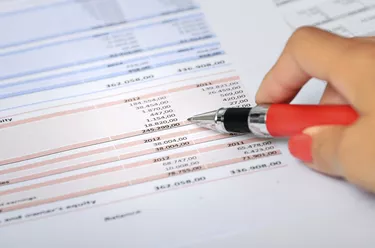
The balance sheet, a main component of a company's financial statements, is used to show the financial conditions of a business on a given date. A balance sheet records all assets, liabilities and shareholders' equity a company has at a specific point in time. The assets represent money uses, and the liabilities and shareholders' equity represent money sources. Recorded correctly, the balance sheet should balance between money uses and money sources, making assets equal to liabilities plus shareholders' equity. Preferred stock represents a money source that is part of the shareholders' equity.
Balance Sheet Construction
Video of the Day
A balance sheet is a two-column configuration of various business transaction items. All items for assets are placed on the left side, and items for liabilities and shareholders' equity are put on the right side. Furthermore, all liability items are placed on the top right, and items of shareholders' equity are placed on the bottom right. The left side of a balance sheet customarily is referred to as the debit side and the right side as the credit side. To increase the dollar amount of a debit or credit item, a debit or credit entry is made on the respective item. To decrease the dollar amount of a debit or credit item, you make a credit or debit entry on the respective item.
Video of the Day
Shareholders’ Equity
Shareholders' equity is an important money source companies use to finance their asset purchases. Preferred stock, common stock and retained earnings are the three main components of shareholders' equity. Any change in shareholders' equity simultaneously affects either an asset item or a liability item. For example, an increase in shareholders' equity may lead to an increase in cash on the asset side or another non-cash asset item, when the increased equity is stored in cash or used to purchase an asset. The increase in shareholders' equity also may lead to a decrease in a liability item, when either the increased equity is used to pay off a debt or a debt has been converted to equity.
Classifying Preferred Stock
Preferred stock is classified as an item of shareholders' equity on the balance sheet. The issuance of preferred stock provides a capital source for investment uses. Preferred stock can be further classified based on the particular type of stock, such as convertible or non-convertible preferred stock. Classification provides as much detailed and special information as possible to balance sheet users. The par value and total shares of the preferred stock also are shown on the balance sheet.
Recording Preferred Stock
Preferred stock normally is recorded at the top of the shareholders' equity section on the balance sheet. When a company issues shares of preferred stock, it records a credit to preferred stock in the amount of the sales proceeds, and a debit to cash, increasing both the equity account of the preferred stock and the cash account, which is a special asset account. If sales proceeds exceed the preferred stock's par value, the surplus is recorded separately as additional paid-in capital.